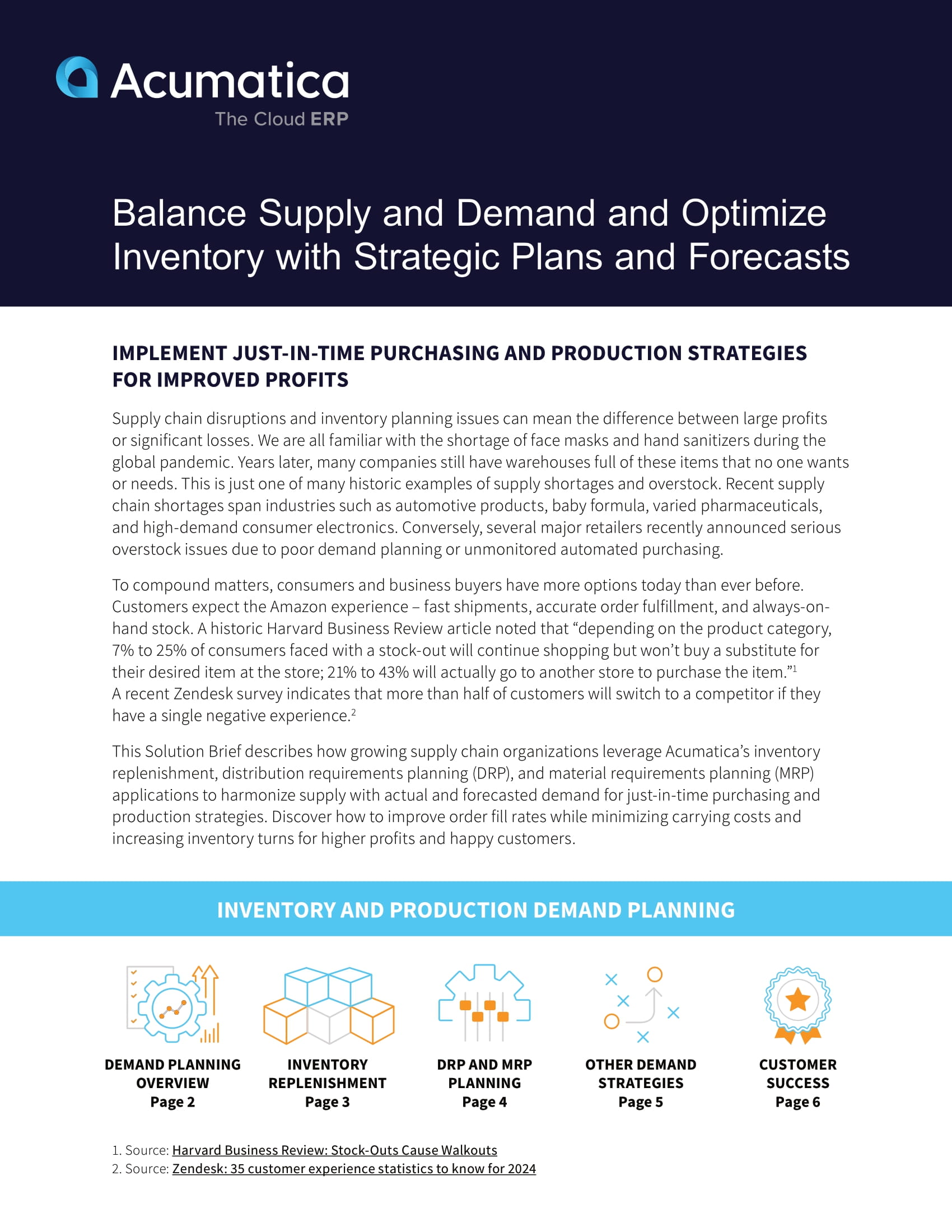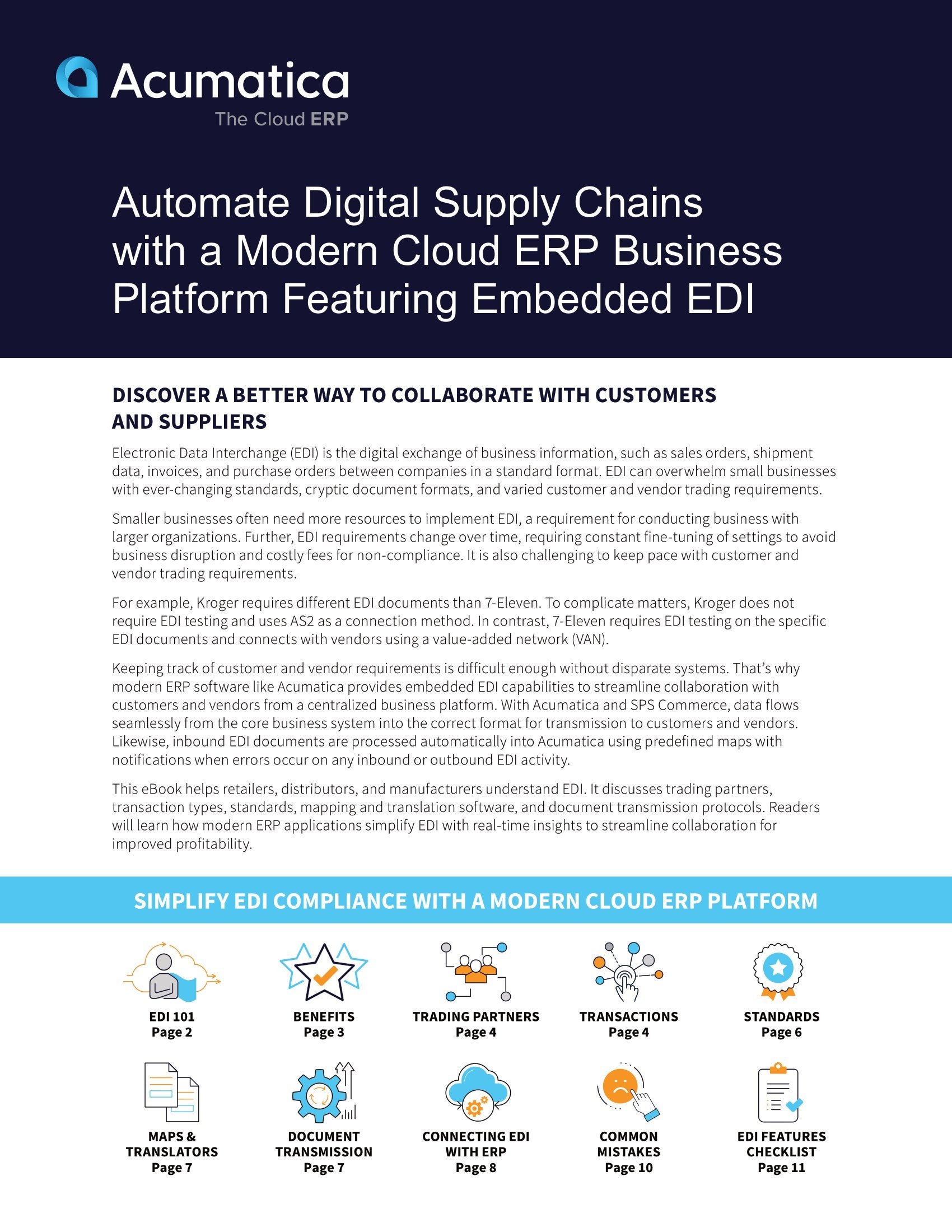
How a Demand Planning ERP Enhances Supply Chain Management
Demand planning is fundamental to business success. Simply put, it’s balancing supply and demand to optimize inventory levels.
Effective demand planning minimizes stock-outs while avoiding excess inventory that ties up working capital and warehouse space.
Demand planning uses sales orders, material requirements for production and projects, forecasts, and other demand sources to determine how many of each product is required to meet demand and when the demand will occur. TechTarget puts it this way: “Demand planning is the process of forecasting the demand for a product or service, so it can be produced and delivered more efficiently and to the satisfaction of customers.”
Predicting demand can be challenging, but the advent of modern demand planning tools—like comprehensive enterprise resource planning (ERP) systems—has helped ease the pain of accurately predicting future consumer behavior. Today, we’ll break down how demand planning works, how it relates to supply chain management, and where ERP solutions fit into the picture.
Understanding Demand Planning in Supply Change Management
Understanding demand planning and its significance to supply chain management is a critical component of successful operations. So, what is the primary objective of demand planning?
Demand planning in supply chain management ensures businesses have the right inventory at the right time, balancing customer demand while preventing overstocking.
Storing and eventually disposing of unwanted products is expensive and increases carrying costs which means an effective demand planning process is critical.
But what does demand management have to do with the supply chain?
The supply chain is the pathway through which a product is created and delivered, starting with those who produce the raw materials and ending with those who deliver the product to the customer. Acumatica’s complimentary guide, “Mitigate Supply Chain Disruption with Acumatica Cloud ERP,” notes that “effective supply chains start with demand planning. Without it, businesses cannot develop supply-side strategies.”
Supply chain demand planning relies on two demand types: real-time orders and forecasted demand based on statistical models. Forecasted demand is based on sales projections and statistical forecast models that account for seasonal fluctuations, marketing programs, inventory factors, and more.
With this in mind, let’s take a look at the steps in the demand planning process.

The Steps in the Demand Planning Process
The first step in the demand planning process is establishing a core team of people from marketing, sales, operations, procurement, and finance. Because the team will be reviewing and analyzing huge amounts of data, it should be led by someone with data management and statistical expertise.
Once this team is established, here are the next steps to creating an effective demand plan:
- Implement or use existing demand planning software (e.g., an ERP solution with seamlessly integrated Supply Chain Management, Customer Relationship Management [CRM], and Point of Sale [POS] applications).
- Use the software to collect and analyze data, including historical, shipment, inventory, and consumer data and seasonal information.
- Agree as a group on the forecasting model (e.g., statistical, market research/surveying, expert opinion, etc.).
- Determine a demand plan and put it into action.
- Monitor the demand plan’s performance using real-time analytics.
- Review and adjust the demand plan on a regular basis.
Demand planning is an ongoing process, and it requires continual data analysis, collaboration, and forecast adjustments that are predicated on real-time, accurate information and evolving market conditions.
Demand Planning and ERP: Role, Benefits, and Challenges
The right demand planning ERP streamlines supply chain demand planning, enabling businesses to anticipate demand and optimize inventory. For instance, ERP solutions centralize businesses’ data, allowing data from every department to flow freely into and out of the system so that every team member has in-person and remote access to updated, accurate information. An ERP solution also automates and simplifies vital tasks, integrates forecasting algorithms, and provides seamless report creation.
In addition to these core functionalities, ERP solutions deliver manufacturing, distribution, project management, and inventory support—such as automating warehouse transactions, supplying inventory replenishment information, identifying material requirements for projects, and tracking data. Further, modern systems like Acumatica provide advanced Distribution Requirements Planning (DRP) capabilities to time-phase demand plans with optional forecasts. They may also include embedded artificial intelligence (AI), which gives businesses the information and ability to create a usable demand forecast.
But even with its real and potential demand-sensing benefits, technology can pose some challenges—especially when it’s new. Challenges include concerns over data quality, the complexity of an ERP implementation, and the reality of persuading employees to learn and use the new technology.
Choosing the right demand and supply planning system requires evaluating software flexibility, integration, and forecasting accuracy. This includes asking the following questions when researching their options:
- Does the ERP solution provide the features required for effective demand planning?
- Is the ERP solution affordable, flexible, and intuitive?
- Is the software vendor trustworthy?
- What do software analysts and other users have to say about the solution?
The answers to these questions will help businesses make the right software choice—as they helped Tim Patton, ICT Director at SAM. He and his team chose Acumatica, and he says, “The quote to cash cycle is the lifeblood of our business, and Acumatica has given us the tools to manage it effectively and efficiently every step of the way. We have valuable tools to see what’s coming, to do all our forecasting through dashboards, and focus on key customers.”

Conclusion
In today’s digital economy, businesses must be technologically savvy. This is especially true for those looking to accelerate their growth through demand planning and to mitigate the challenges that come with enduring supply chain disruptions.
By taking advantage of a comprehensive ERP solution like Acumatica, modern businesses have the tools they need to bring their data into one place, the demand planning features for analyzing that data, and the ability to use the resulting information to create a smart demand plan that truly reflects consumer demand.
 Canada (English)
Canada (English)
 Columbia
Columbia
 Caribbean and Puerto Rico
Caribbean and Puerto Rico
 Ecuador
Ecuador
 India
India
 Indonesia
Indonesia
 Ireland
Ireland
 Malasya
Malasya
 Mexico
Mexico
 Panama
Panama
 Peru
Peru
 Philippines
Philippines
 Singapore
Singapore
 South Africa
South Africa
 Sri-Lanka
Sri-Lanka
 Thailand
Thailand
 United Kingdom
United Kingdom
 United States
United States







